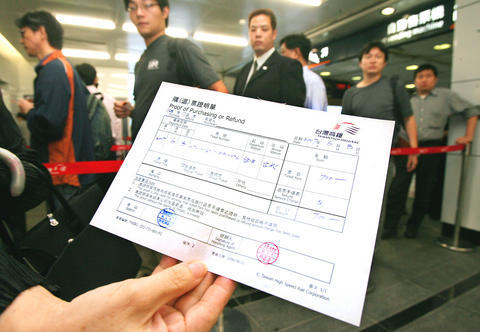Affected by heavy downpours, the nation's high-speed rail suffered its longest delay yesterday morning since the service started in January.
Nine bullet trains, including four northbound services and five southbound, were delayed by more than half an hour, said Ted Chia (賈先德), assistant vice president of Taiwan High Speed Rail Corp's (THSRC, 台灣高鐵) press office.
"By 4:30pm, there were 1,220 passengers who were granted refunds," he said at a press conference yesterday.

PHOTO: WANG YI-SUNG, TAIPEI TIMES
A total of 4,520 passengers had booked tickets on the nine trains, said THSRC public affairs manager Christina Tao (
THSRC allows passengers arriving at their destinations half an hour after the scheduled time to receive a 50 percent refund, while a 100 percent refund is given to those arriving more than one hour late.
Eight of the trains reached the destinations late because of heavy rains in Miaoli County.
Sensors deployed at slopes to detect landslip near the track were activated in the morning, causing two trains to stop for around nine minutes. They moved on at a slower speed of 45kph when it was confirmed that passengers were in no danger, THSRC said.
The slower speed caused subsequent trains to miss their schedules.
Another train departed from Tsoying (
Vibration sensors on the train's 10th carriage were activated during the trip and technicians boarded the service at Taichung to examine the alert.
"Our initial check suggested a sensor circuit malfunction. We ruled out any human factor," Chia said.
Bad weather was the cause of the delays and precautions were taken according to procedure, he said, adding that the bullet trains were built to withstand rainy weather and typhoon conditions.
The company would compensate passengers on a case by case basis if delays happened again, he said.
The delays and losses from ticket refunds came a day after the company said that it was expecting to break even next month.
During a ceremony on Thursday to celebrate a NT$65.5 billion (US$2.0 billion) syndicated loan, THSRC chairwoman Nita Ing (
THSRC has now secured a total loan pool of NT$373.8 billion.
There are 31 services in each direction on the high-speed railway. Ing said full utilization of system capacity would raise that to a total of 88 commercial and maintenance train runs per day.
The number of trips in each direction was scheduled to increase to 41 or 42 per day next month, Ing said, and then to 61 in September.
"Ultimately, we hope to expand the total number of daily train runs in each direction to 88," Ing said.
THSRC is expected to start an online ticket reservation system next month. The company will also start automated voice ticket reservation services in September.
Ing said on Thursday that the company, which is listed on the Emerging Stock Market (

The US dollar was trading at NT$29.7 at 10am today on the Taipei Foreign Exchange, as the New Taiwan dollar gained NT$1.364 from the previous close last week. The NT dollar continued to rise today, after surging 3.07 percent on Friday. After opening at NT$30.91, the NT dollar gained more than NT$1 in just 15 minutes, briefly passing the NT$30 mark. Before the US Department of the Treasury's semi-annual currency report came out, expectations that the NT dollar would keep rising were already building. The NT dollar on Friday closed at NT$31.064, up by NT$0.953 — a 3.07 percent single-day gain. Today,

‘SHORT TERM’: The local currency would likely remain strong in the near term, driven by anticipated US trade pressure, capital inflows and expectations of a US Fed rate cut The US dollar is expected to fall below NT$30 in the near term, as traders anticipate increased pressure from Washington for Taiwan to allow the New Taiwan dollar to appreciate, Cathay United Bank (國泰世華銀行) chief economist Lin Chi-chao (林啟超) said. Following a sharp drop in the greenback against the NT dollar on Friday, Lin told the Central News Agency that the local currency is likely to remain strong in the short term, driven in part by market psychology surrounding anticipated US policy pressure. On Friday, the US dollar fell NT$0.953, or 3.07 percent, closing at NT$31.064 — its lowest level since Jan.

The New Taiwan dollar and Taiwanese stocks surged on signs that trade tensions between the world’s top two economies might start easing and as US tech earnings boosted the outlook of the nation’s semiconductor exports. The NT dollar strengthened as much as 3.8 percent versus the US dollar to 30.815, the biggest intraday gain since January 2011, closing at NT$31.064. The benchmark TAIEX jumped 2.73 percent to outperform the region’s equity gauges. Outlook for global trade improved after China said it is assessing possible trade talks with the US, providing a boost for the nation’s currency and shares. As the NT dollar

PRESSURE EXPECTED: The appreciation of the NT dollar reflected expectations that Washington would press Taiwan to boost its currency against the US dollar, dealers said Taiwan’s export-oriented semiconductor and auto part manufacturers are expecting their margins to be affected by large foreign exchange losses as the New Taiwan dollar continued to appreciate sharply against the US dollar yesterday. Among major semiconductor manufacturers, ASE Technology Holding Co (日月光), the world’s largest integrated circuit (IC) packaging and testing services provider, said that whenever the NT dollar rises NT$1 against the greenback, its gross margin is cut by about 1.5 percent. The NT dollar traded as strong as NT$29.59 per US dollar before trimming gains to close NT$0.919, or 2.96 percent, higher at NT$30.145 yesterday in Taipei trading